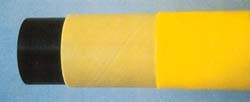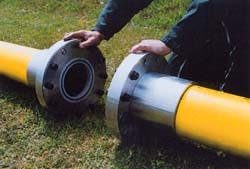RTP pipe consists of a primary tube in HDPE (left), several crossed layers of Aramid yarns coated with HDPE (center), and an outer layer (right) of HDPE for external protection (Fig. 1).
Mechanical-resistance tests on reinforced high-density polyethylene (HDPE) pipe have confirmed its service pressure of up to 150 bar (2,175 psi) in temperatures of -30° C. (-22° C.) to 30° C. (86° F.).
The pressure ranges vary with the number of reinforcement levels. At greater than 30° C., the service pressure must be reduced by 10 bar for each 10° C. increase.
The tests were conducted by Shell International, The Hague.
The pipe has heretofore been used only in low pressure and low temperature settings. It is manufactured by Tubes d'Aquitaine, Carsac, France, and supplied as Reinforced Thermo Plastic (RTP) pipe.
The company says the pipe, which has a 50-year service life, is the only tube for transporting gas at high pressure which can resist strong seismic movements with an axial elasticity of 1.5%.
Shell also sponsored tests by an independent Dutch laboratory on the pipe's connector systems.
Tubes d'Aquitaine says British Gas will conduct a field trial of its Type B270 (6-in.) RTP pipe by the end of this year. And Saudi Aramco has also indicated plans to conduct field tests, of Type D250 (9-in.) RTP pipe.
Petroleum Development of Oman (PDO) in a field trial in November will install a 10 km, 6-in. flow line and plans to install a 40-km line early next year.
Three layers
Polyethylene tubes have been used for transporting liquids and gases at low pressure for more than 40 years. The material was used only at low pressures because of the limits of its mechanical resistance.
Research efforts by Tubes d'Aquitaine, however, led to development of a new technology for manufacturing a range of RTP pipe able to transport liquid and gas at high pressures with the same advantages of polyethylene at low pressures.
The company says that RTP gives operators an alternative to carbon steel pipe when fluids to be transported are corrosive. In some producing fields, leaks appear on flow lines only 6 months after carbon steel pipe has been installed. That was the case in many places in Oman.
In several fields, PDO was having to change out some carbon steel pipe after only 1 year of service, as opposed to the industry norm of 2-3 years. Efforts to repair leaking pipe with polyethylene liners worked for water transportation but not for crude oil and gas.
Repair of one leak, PDO estimated, costs about $5,000. In some small fields, several hundred leaks were appearing every year.
RTP, on the other hand, can work without problems for 15-25 years, says Tubes d'Aquitaine, depending on operating temperatures.
RTP pipe consists of three parts:
- A primary tube in HDPE
- Several crossed layers of Aramid yarns coated with HDPE, perfectly welded to each other and to the primary tube (Fig. 1 - above).
- For external protection, a layer of HDPE is perfectly welded to the assembly.
Aramid fibers (for example, Kevlar and Twaron) are used for manufacturing bullet-proof vests and butcher's gloves. The long-term performance of these fibers is well known, their having been used in many industrial applications for more than 20 years.
Aramide fibers work inside the RTP pipe as steel works inside reinforced concrete.
The reinforced HDPE pipe may be used in temperatures ranging from -40° to 60° C.
The structure of the pipe with all the yarn gives a high level of regularity and prevents crack propagation if the pipe is punctured during installation.
Tubes d'Aquitaine says that RTP pipe used for transporting water or gas at high pressures provides an energy saving of 25%, compared to carbon steel pipe.
With the same power input, RTP pipe provides approximately 20% extra flow rate. This means that a 240 mm ID pipe is comparable to a 12-in. carbon steel pipe; a 16-in. RTP pipe will be about as efficient as a 20-in. carbon steel pipe.
Tubes d'Aquitaine designs and produces RTP pipe and identifies each by letter and number codes that correspond to the dimensions and mechanical performance. For example, in B270, "B" corresponds to an ID of approximately 6 in.; "270," to the material's mechanical resistance.
Following are standard types (service pressures all at -30° to 30° C.):
- A240: 143 mm OD; 110 mm ID; 80 bar
- B270: 179 mm OD; 144 mm ID; 100 bar
- D250: 273 mm OD; 230 mm ID; 85 bar
Other types that can be delivered within 2 months include:
- A450: 107 mm ID; up to 160 bar
- B420: 140 mm ID; up to 150 bar
- D150: 230 mm ID; up to 55 bar
Four additional types are being considered:
- C200: 185 mm ID; 75 bar
- C300: 185 mm ID; 110 bar
- E180: 295 mm ID; 60 bar
- E270: 295 mm ID; 90 bar
Although polyethylene is insensitive to corrosion, temperatures at which it can be used are limited.
As stated, the service pressures must be reduced by 10% for every 10° C. of temperature increase, the limit for RTP pipe and polyethylene standards being 60° C.
B270, for example, is manufactured for a service pressure of 100 bar for use at -30° C. to 30° C. Its service pressure will be up to 90 bar for 30-40° C., up to 80 bar for 40-50° C., and up to 70 bar for 50-60° C.
For a flow line application, says the company, it is possible to use B270 at 90 bar at 50-60° C., but in this case the lifetime of the tube will be reduced from 50 to 20 years.
Testing
Shell carried out the mechanical resistance tests at high pressure to establish the limitations of the new design and to determine the tubes' exact lifetimes. The physical, chemical, and thermal behaviors of the material, says Tubes d'Aquitaine, have been known for many years.
Shell conducted four types of tests:
- Static tests under constant pressure
- Cyclic tests with rapid pressure increase to 150 bar and decrease to 0 bar
- Axial resistance tests
- Tests at high pressure with a temperature of 50° and 60° C.
The tests' results indicated that PE-reinforced tubes can be used for a service pressure ranging from 50 to 150 bar, depending on the number of reinforcement layers, and have a lifetime of more than 50 years when used between -30° C. and 30° C. The tests confirmed that, at greater than 30° C., the service pressure must be reduced by 10 bar for each 10° C. of increase.
Shell also conducted a test to verify axial stability and mechanical performance of tube Type B270. The test showed that at 100 bar, the ID increases by 2%, from 144 to 147 mm.
Several cyclic tests were conducted to verify the axial stability and the behavior in the radial direction. After 1,000 tests of the cyclic internal pressure from 0 to 150 bar, the ID was 145 mm at 0 bar and 148 mm at 100 bar.
Axial elongation was insignificant.
Shell also conducted several tests to establish the maximum load in axial direction by pulling on the two end-caps.
Fig. 2 [48348 bytes] shows elongation and axial resistance of B270 and thread resistance inside the connector as well as performance of the seal.
With an internal pressure of 90 bar inside B270, failure appears when the load reaches 177 kN. Without internal pressure, the coupling failed when the load reached 94 kN. The unique concept behind RTP's seals is responsible for this phenomenon and will be discussed presently.
These tests show that it is possible, with a cable connected to the flange, to pull a long length of RTP pipeline, for example, over hills.
By affixing a buckle with a breaking point of 2 tons between the cable and the flange, the empty pipeline will be moved with a safety factor of 4.
For offshore applications, B270 can resist currents and other forces up to 60 kN with a safety factor that corresponds to the lifetime of the tube, says Tubes d'Aquitaine.
RTP pipe can be joined with two flanges (Fig. 3).
Connections; test results
The pipe can be connected via two flanges (Fig. 3) in a configuration that precludes the need for sophisticated control equipment because the strength of the bolts in the flanges is known.
Alternatively, welding of steel or polyethylene pipes is always a long and delicate field operation and inevitably produces a weak spot because of modifications from the temperature increase in the material.
Screwed pipe connections, however, provide the best mechanical connection for RTP pipe, says the company. And it has developed and patented its own.
The quick connection system employs a treated aluminum alloy sleeve with a specific screw thread manufactured by Tubes d'Aquitaine. Pipe is shipped to the field with the sleeve fitted over one threaded end RTP pipe. In the field, the sleeved and un-sleeved ends are mated.
Two sealing systems have been designed.
In the first, a rectangular shaped seal which is seated in a groove at the end of one pipe is compressed by the end of the other pipe, which is perfectly smooth and parallel to the seal (Fig. 4a [51649 bytes]).
The second system is based on two conic sections which are compressed against one another, polyethylene against polyethylene (Fig. 4b).
Sealing in both cases uses the radial pressure naturally exerted from inside the pipe by the pressurized medium. The forces from radial pressure act against the thread of the connector which, exhibiting virtually no elongation, is in opposition to the axial forces. Thus, the B270 coupling failed at a lower test load (94kN) without internal pressure than at the higher test load (177 kN) with internal pressure.
Both connection and sealing systems have been patented. Length of the connector varies with the operating pressure and ID of the pipe being connected.
In addition to the tests carried out in its Amersterdam laboratory, Shell commissioned tests on the efficiency and performances of the connection manufactured by Tubes d'Aquitaine. These tests were conducted by MARC, an independent research analysis company based in Zoetermeer, Holland.
Following are results of these tests and calculations for Type B270:
- At 20° C., age 0: burst pressure 270 bar
- At 20° C., age 20 years: burst pressure 170 bar
- At 60° C., age 0: burst pressure 259 bar
- At 60° C. age 20 years: burst pressure 163 bar
The results of this study confirm that, at both 20° and 60° C., the connection has both short and long-term performances superior to the tube itself.
Installation
RTP pipe comes in 12-m lengths for its 4, 6, and 10-in. ID pipes. The company says these 12-m lengths, screwed end to end, provide the optimum solution for onshore applications, particularly for pipe 4-12 in.
The company says RTP can be installed very quickly: Without a crane, a 6-in. pipe for 100 bar operating pressure can be installed at a rate of 200 m/hr by three technicians and 12 workers.
Installation starts with a flange that is attached to some fixed part (pump, valve, for example), then tubes are screwed end to end until the other flange is reached, which is also attached to a fixed part.
As the pipes all have right-hand threads, they cannot unscrew themselves on shore applications. When the pipeline is in service, unscrewing any joint is impossible.
Tubes d'Aquitaine says that a threaded connection with a safety seal has many advantages that are lost when pipe is welded.
For example, repair of a pipe that has suffered third-party damage from, say, earth-moving equipment, can be cut, screwed out, and replaced with two 6-m tubes with two flanges. Repairing a damaged pipe takes 2 hr.
Copyright 1996 Oil & Gas Journal. All Rights Reserved.



